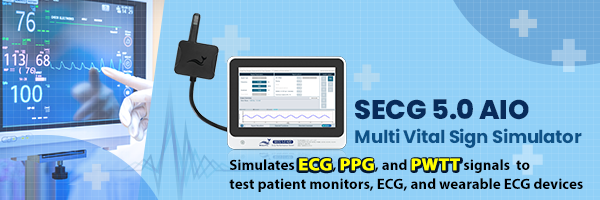
As the aging society grows, the demand for home healthcare is increasing, and individuals monitoring their own physiological status has become more prevalent in daily life. For instance, using home-based patient monitors to test heart rate, blood oxygen saturation, and blood pressure, or utilizing smartwatches to track heart rate and blood oxygen levels, allows continuous monitoring of the body's condition. When anomalies appear, individuals can seek further medical attention, and long-term monitoring data can serve as clinical reference information. To assist manufacturers in developing patient monitoring devices and wearable products, WhaleTeq announced today (15) that the upgraded SECG 5.0 AIO can collaborate with the PPG-2TF-660 Transmittance SpO2 Module for SpO2 and PWTT (Pulse Wave Transit Time) testing.
During the product development process, manufacturers' research and development personnel require precise human vital sign simulators to verify the accuracy of interpretation capabilities. The WhaleTeq SECG 5.0 AIO is specifically designed for performance testing with built-in circuits conforming to the latest ECG standards and upgraded to work with the PPG-2TF-660 module to simulate PPG signals for testing the performance of SpO2 functionality. In the SpO2 test mode of the new SECG 5.0 AIO user interface, developers can freely select AC, DC, and PI parameters of red and infrared light, then fine-tune their values in a small step size to confirm the accuracy of blood oxygen measurement algorithms. It also allows customizing or loading an R curve for quickly verifying blood oxygen detection performance or comparing against competitors' measurement designs.
In response to the versatile functions of patient monitors, the SECG 5.0 AIO working in conjunction with the PPG-2TF-660 module enables the testing of PWTT functionality by synchronizing ECG and PPG signals. It provides flexibility in adjusting the time difference of PWTT to confirm the accuracy of non-invasive blood pressure (NIBP) measurement algorithms. Furthermore, to assist developers in testing products under conditions closer to real-world usage scenarios, the SECG 5.0 AIO offers 14 types of ambient light signals and respiratory variation simulation for superimposing on output waveforms, simulating the interference caused by ambient light and human respiration on the detection of vital signs, thereby verifying the reliability of interpretation capabilities.
The upgrade of the SECG 5.0 AIO expands its application from ECG and wearable ECG devices to patient monitors by effectively testing ECG, SpO2, and PWTT functionalities. To meet the performance verification needs of a wide range of patient monitoring devices and wearable products, WhaleTeq plans to introduce the SECG 5.0 AIO future compatibility with reflectance SpO2 module, advanced respiration module, and impedance cardiography (ICG) module to assist more manufacturers in the development and safeguard the health of users together.
For more information, please visit the product page: SECG 5.0 AIO